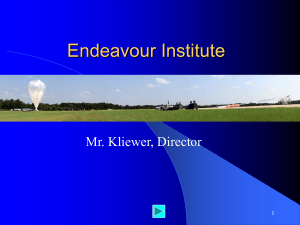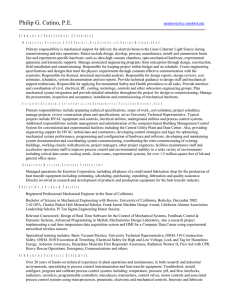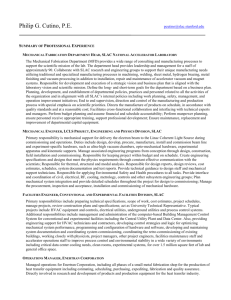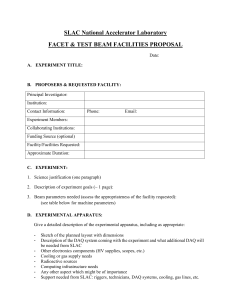FACET User Support plenary Hast
advertisement
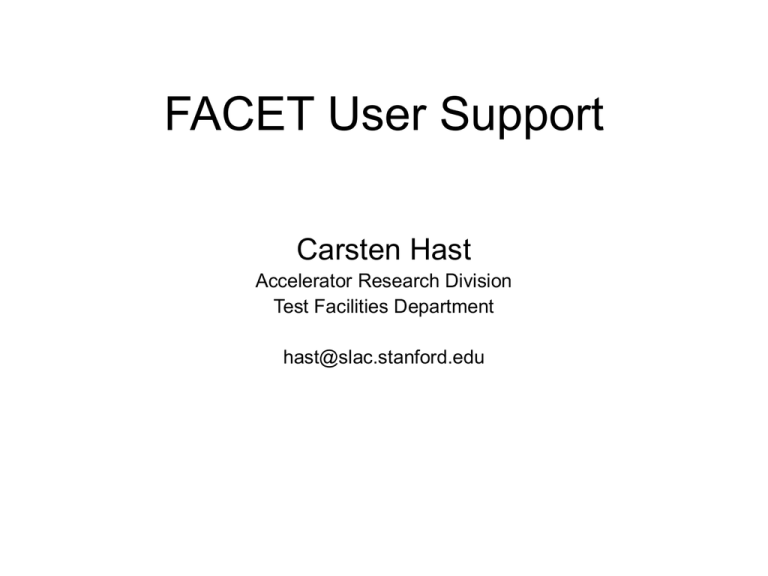
FACET User Support Carsten Hast Accelerator Research Division Test Facilities Department hast@slac.stanford.edu Apologies • I was rather distracted with work for a new Test Beam Project at SLAC: End Station A Test Beams (ESTB) • Use 5 Hz of LCLS 14.6 GeV e- beam in ESA for ILC style Machine Detector Interface and Beam Delivery System studies • Can produce single electrons and hadrons for detector development studies • Interested? e-mail to hast@slac.stanford.edu 3/18/2010 FACET User Support hast@slac.stanford.edu 2 Past to Future • Until 3 years ago the Experimental Facilities Department (EFD) supported users in FFTB and ESA etc. • Since 2 years Test Facilities Department (TF) is operating ESB and NLCTA – Mostly SLAC, no users • Since this year TF is supporting all test facilities (ASTA, ESA, ESB, FACET, NLCTA) – All programs are growing at the same time – TF is growing (currently 2 Techs, 2 DAQ/Controls, 1 LLSO, 5 Physicists) – Developing user support • Here is what we can do • Tell us what you need 3/18/2010 FACET User Support hast@slac.stanford.edu 3 Users @ SLAC • A SLAC PI will be assigned to each experiment • Training requirements – Every user will need a SLAC computing account – Many training items can be done remotely via web training – Couple of things on first day of arrival • Need to clarify what general training will be needed • Will setup a web page which will lay out what you need to do and when (no training, no work) 3/18/2010 FACET User Support hast@slac.stanford.edu 4 After your proposal is accepted Experimental setup needs review and approval to be installed and operated at SLAC – Safety Oversight Committee (SOC) • Brand new process (rolled out on March 1st) • Looks at experimental equipment and will request Safety Officers and others to review your setup – TF will be instrumental in getting the necessary approvals for you • • • • • We know how the system works We are part of the system We can do many things for you – If you tell us what you want to do This process can be quite fast for “normal” setups But if you’ll need “more exotic” components (e.g. hazardous gases) will take more time – Electrical components need to be UL listed (or equivalent) • That’s a tough one, because many devices you are using in your home institutes are not! • SLAC has an inspection process to approve non listed devices – TF can do that – Radioactive sources need to be registered with RP 3/18/2010 FACET User Support hast@slac.stanford.edu 5 Resources @ SLAC • With the end of EFD we lost some capabilities for machining parts, especially quick turn around and installation support – Need to reestablish that, though I fear it will be on a reduced level compared to years ago • • • • • • Mechanical Fabrication Department (MFD) is very good, but can be slow Most of the vacuum work will be done by the SLAC vacuum shop needs scheduling Heavy equipment needs to be lowered by the SLAC Riggers needs scheduling Alignment group is available on short notice, but fiducialization will need time If you need things which don’t exist yet (special gases, cables, lasers, etc.) we need time (and money) to install these Special DAQ needs will need time to be implemented TF should be your point of contact to start your quest to be successful at SLAC 3/18/2010 FACET User Support hast@slac.stanford.edu 6 Location of FACET • More or less in the middle of nowhere • Will establish a User building this year at S20 – Parking will be interesting – Bicycling is a good option • Need lights • Can be quite wet in winter • Underground without easy access Very careful planning of the experimental setup, the installation procedure and the operation is key to success • Carrying equipment up and down the stairs is very limited (I don’t want to see anybody in the middle of the night carrying a scope in their hands into the tunnel!) • Need to install a small crane to lower stuff up and down ourselves • Tool box down in the Linac (need to know what you will need) • Very small workshop (drill press, saw etc.) in klystron gallery but remember: No training, no work! 3/18/2010 FACET User Support hast@slac.stanford.edu 7 Reuse of old FFTB equipment • We build quite a few specialty items, like the sliding vacuum table with 2 beam lines – Reuse • The FACET user community should agree on some common tools, dimensions etc. to make life easier, faster and cheaper • Mark and I will list some inventory of things we have available 3/18/2010 FACET User Support hast@slac.stanford.edu 8 Summary • Users will have a SLAC PI who will be responsible for their training assessment and work authorization and work release • Users will be responsible to only do what they have been trained, authorized and released to do • TF will be your point of contact to get started with your equipment here at SLAC • TF will assist with equipment installation and the coordination with other services needed (rigging, vacuum, alignment, etc) • Special requests (DAQ, hardware, gas, laser) will need time to be implemented • Careful planning ahead will be a key ingredient to make you experiment a success 3/18/2010 FACET User Support hast@slac.stanford.edu 9
